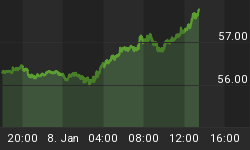Below is an extract from a commentary originally posted at www.speculative-investor.com on 29th March 2007.
The gold sector versus the broad stock market
The long-term trend for the gold sector is always the opposite of the long-term trend for the broad US stock market. For example, the gold sector was in 'bull mode' during the 1960s and 1970s while the S&P500 was in 'bear mode'. The long-term trends then reversed, with the S&P500 embarking on a bull market that extended through the 1980s and 1990s while the gold sector suffered a 20-year bear market. And then, in 2000, the long-term trends reversed direction again. This has led, since the beginning of September-2000, to the S&P500 falling from 1520 to its current level of 1417 -- a small nominal loss of around 6% over the space of 6.5 years and a huge loss in real terms -- and the AMEX Gold BUGS Index (HUI) rising from 51 to 340 for a nominal gain of 568%.
Let's now consider a shorter timeframe that bypasses all except the last few months of the S&P500's 2000-2002 cyclical bear market. Specifically, we'll consider the period from 1st May 2002 through to the present day.
As evidenced by the following chart, the HUI and the S&P500 both trended higher throughout much of this period. Note, however, that the upper and lower sections of the chart have very different scales, so even though the performances of the two markets are visually similar the HUI's gain of 209% dwarfs the S&P500's gain of 35%.
In any case, our main reason for including the following chart isn't to highlight the HUI's out-performance; it's to illustrate that every short-term downward trend in the broad stock market over this 5-year period was accompanied by a short-term downward trend in the gold sector (the shaded areas on the chart are the periods when the S&P500 was in a short-term downtrend). There wasn't a single exception. Therefore, the idea that the gold sector will be able to 'buck the trend' should the current stock market correction continue for a while is not well founded.
The converse also applies, in that with some brief exceptions -- last September, for instance -- the HUI was never in a short-term downtrend over the past 5 years unless the S&P500 was also trending lower. This suggests that the HUI won't do worse, over the next few weeks, than drop marginally below its early-March low unless the broad stock market becomes a lot weaker in the near-term than we currently expect.

Our expectation is that the gold sector will begin to trend in the opposite direction to the broad stock market within the first few months of the next cyclical bear market in equities, but as long as the cyclical bull market in US equities remains in force the gold sector will probably be hurt by stock market corrections and helped by stock market rallies.
The Sluggishness of the Major Gold Stocks
The major gold stocks remain sluggish. At the same time, many of the gold and other metal stocks that reside at the speculative end of the sector have been performing well. The recent rally in the juniors has been nowhere near as broad-based or frenetic as the one that occurred during the first four months of 2006, but there have certainly been some impressive gains of late.
That the juniors, as a group, have been trading much better than the majors suggests that retail investors are presently more bullish on gold stocks than professional investors. And if this is the case it could be explained, in part, by the following chart comparison of the HUI and the gold/CCI ratio (the gold price divided by the Continuous Commodity Index). Whereas many members of the retail investing public have been conditioned to believe that across-the-board rises in commodity prices are bullish for gold stocks, any professional investor worth his/her salt would realise that rises in the prices of oil and other commodities put DOWNWARD pressure on the profit margins of gold mining companies and are thus bearish for gold stocks unless the gold price is rising even faster.
The point is that the backdrop will only ever be genuinely bullish for gold producers when gold is trending higher relative to commodity prices in general. At the moment, the major gold stocks are doing pretty much what they should be doing given the sluggishness of the gold/CCI ratio.

















